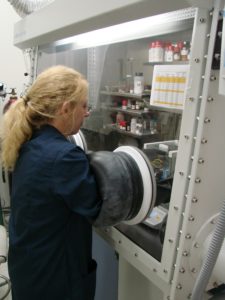
Dr. Jackie Johnson
When Jackie Johnson started researching glass 25 years ago, she didn’t realize she was on the so-called cutting edge.
“What we’re doing is finally in fashion,” laughed the professor of mechanical, aerospace, and biomedical engineering at the UT Space Institute.
That’s because, according to some scientists, we are in the “Glass Age.” Think of it; almost everything we use today has glass—from touchscreens on our smartphones, to computers, buildings, automobiles, and thousands of other applications around the world.
What makes glass so prevalent is its versatility. It can be made in almost any shape or size. It has a wide range of useful properties—and therefore a wide range of applications.
“With glass, you can add a component to it and get totally different properties,” Johnson said. “But it isn’t easy to do. Glass is an amorphous material with a short-range order so it’s hard to pin down a definitive structure of the material.”
The challenge is what’s attracted Johnson to glass. She loves that it makes her think and holds promise for Johnson to make a big impact in people’s lives.
Among many areas, Johnson is studying glass to improve medical imaging. By mixing certain compounds she can produce a glass-ceramic image plate. Unlike other imaging materials, glass is transparent. It doesn’t scatter light, which keeps images sharp.
Sharper images mean earlier detection of diseases like cancer. It can also mean less costly health care.
“In a large hospital setting, with digital radiography technology, many expensive detector systems are needed for x-ray readout. With our technology, based on computed radiography (CR), the images are projected onto the glass plates, which store the images. Then you only need one central system to read the image plates,” Johnson explained.
Similar CR technology is used in many parts of the world, including the US, but the images aren’t as sharp as Johnson’s work, which won an R&D100 award in 2007.
Other projects Johnson is involved with include development of sodium ion batteries, diamond-like carbon films for biomedical applications, and treatment for cancerous tumors using magnetic fields.
Despite being in a so-called Glass Age, the number of rising glass scientists is low. This is something Johnson is trying to change. She started an internship program at UTSI where several students ended up becoming graduate students at the institute, working on glass-related projects.
She also has funding from the Ceramic and Glass Industry Foundation to put on a twice-yearly lecture series hosted by her graduate students to educate local high school students on the merits of working in glass and ceramics.
“There are a surprisingly large number of glass industries in Tennessee across several disciplines such as automobile manufacturing. In fact, Tennessee ranks number one in the country for automotive manufacturing strength,” Johnson shared.
There are operations for Nissan, General Motors, and Volkswagen to name a few, as well as multiple window glass companies and bottling companies, such as Coca Cola, and a large battery complex for Nissan. “The region is primed for glass development and manufacturing so there is a need to educate our youth on the potential for great research careers,” explained Johnson, who is keen for others to be in fashion, too.
By Whitney Heins